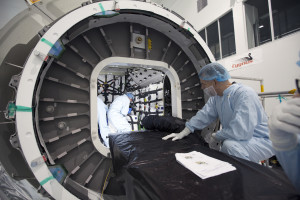 On the OA-5 mission, Cygnus will carry supplies and equipment to the International Space Station, as well as science payloads. The total mass of the cargo is approximately 2,425 kg (5,346 lb.), which includes 56 cargo bags of multiple sizes.
On the OA-5 mission, Cygnus will carry supplies and equipment to the International Space Station, as well as science payloads. The total mass of the cargo is approximately 2,425 kg (5,346 lb.), which includes 56 cargo bags of multiple sizes.
Payloads:
- Spacecraft Fire Experiment-II (Saffire-II)
- Fast Neuron Spectrometer
- ACM and Experiment Tray
- SLMMD
Cargo:
- ISS Experiment Hardware
- EVA Equipment– EMU Repair Kit– EVA Supplies
- Emergency Equipment
- Photo/TV and Computer Resources– Computer – iPad Air 2
– Laptop – T61P and Connectors – Camera – Nikon D4 - ISS Hardware and Spare ORUs – Cupola Scratch Panes
– Water ORU - Food, Crew Supplies and Crew Provisions
- Flight Crew Equipment
- Cargo Environment SensorsAdditional payload details can be found at www.nasa.gov/iss-science.
The Saffire-II experiment will start a controlled fire on the Cygnus capsule after it departs the station to observe and measure how the fire behaves in micro-gravity.
“One of the least understood risks in space is how a fire starts, how it propagates, how you will detect the fire and how you put it out,” said Jintendra Joshi, Saffire technology integration lead for the Advanced Exploration Systems Division at NASA Headquarters.
Future experiments will try burning in different conditions, then investigate strategies for putting fires out.
The Cool Flames experiment will investigate why some combustible materials seem to burn at a lower-than-expected temperature in micro-gravity. “In certain cases with certain fuels something unexpected happens that can’t be replicated on the ground,” said Jesse Robins of NASA’s Glenn Research Center.
What you see, he said, is after an initial hot burn the visible flame extinquishes but the fuel droplet size diminishes at a faster rate than evaporation would suggest. Sometimes the fuel can re-ignite, he said, “like a trick birthday candle.”

Is there a somewhere at the launch available to the public to watch the launch?
I’d suggest packing some food and heading out to the Visitors Center before too late. It does tend to fill up. Robert Reed Waterfront Park in downtown Chincoteague is popular.
Don’t go to the National Seashore, Arbuckleneck Rd. or Chincoteague Rd., Those places are always closed for a launch this size.
Here’s a website with more detailed information: https://www.nasa.gov/ce…/wallops/events/viewing_launches.html